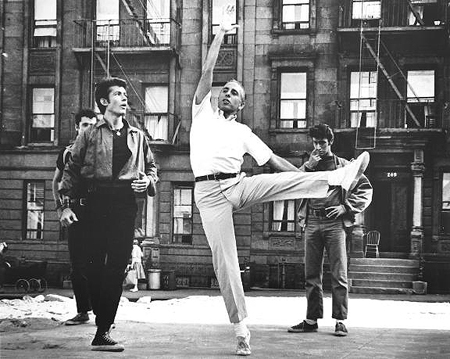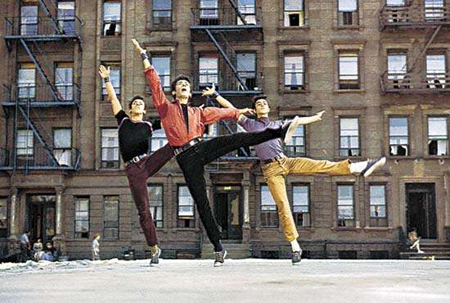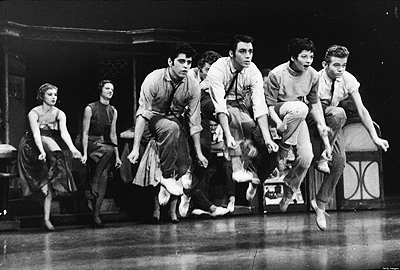Theater: Choreography: Intrinsic or Replaceable?
By Wendy Caster
arttimesjournal July 28, 2018
In some ways, it’s exciting news: Director Ivo van Hove will stage a production of West Side Story, with new choreography by Anne Teresa De Keersmaeker. Van Hove says he aims to bring the show “into the 21st century.” De Keersmaeker says, “The challenge will be to offer a new reading.” Their ultimate goal is to revitalize a classic.
 Jerome Robbins (center) demonstrating a dance combination for George Chakiris (left) for the movie version of West Side Story. |
But does West Side Story really need a new life? Van Hove, De Keersmaeker, and producer Scott Rudin obviously think it does. And no less an eminence than Stephen Sondheim (who wrote the lyrics for West Side Story) is on board. He says, “This is Ivo van Hove’s first Broadway musical, and I’m eager to see what he does with it. What keeps theater alive over time is reinterpretation, and when that reinterpretation is as invigorating as his productions of A View from the Bridge and The Crucible, it makes for something to look forward to with excitement.”
Sondheim is known for his openness to new interpretations of his work, sometimes to the extent that he allows his shows to be battered into completely new, lesser beings: a Sweeney Todd with no slit throats; a Company where the couples don’t interact; an A Little Night Music with many in the cast too young to have the requisite world-weariness. But I wonder if even he, for all his openness, would be excited if someone presented a version of West Side Story with new music and lyrics.
 Robbins’ choreography for the Jets from the movie version of West Side Story. |
For me, the essence of West Side Story is a choreographic moment, when Tony and Maria come together palm to palm during the dance in the gym. More importantly, Robbins’ choreography defines the gangs. And I have to wonder, why is choreography considered to be a replaceable component of a musical?
Admittedly, in some cases, choreography truly isn’t intrinsic to a show. In these cases, the librettist, composer, and lyricist have completed the writing before the choreographer is even hired on.
The Center Theatre Group defines choreographer as follows:
A theatrical choreographer creates the dance elements in a play or musical, and often teaches them to actors, singers, and dancers. Choreographers work with the creative team—especially the director and, if they're available, the composer—to decide what kind of movement will help to tell the story or support the vision of the piece... They are usually hired on a per-show basis as contractors…
Following this definition, choreography is more similar to the performances of the actors and musicians than to the writing of the show, since the choreographer is hired on to interpret/add to a piece rather than to develop it.
 Robbins’ choreography from the Broadway version of West Side Story. |
But Jerome Robbins was no ordinary choreographer. He was part of West Side Story from its inception; in fact, the idea to base a musical on Romeo and Juliet was his. Robbins was as involved with the show’s creation as Sondheim, Leonard Bernstein (composer), and Arthur Laurents (book), if not more so. (He was also the director.) He’s a necessary part of the show’s DNA.
While Robbins’ level of involvement in West Side Story may have been unusual, Michael Bennett was similarly involved in A Chorus Line. I suppose that someday someone will want to produce that show with new choreography, but will it really be A Chorus Line? And will this new West Side Story really be West Side Story?
If I can get an affordable ticket to see this production, I may give it a chance. I don’t want to age into the sort of person who is against anything new. Nevertheless, I feel that this redo is disrespectful to Jerome Robbins and his enormous contribution to the American musical.
( Wendy Caster is an award-winning writer living in New York City. Her reviews appear regularly on the blog Show Showdown. Her short plays You Look Just Like Him and The Morning After were performed as part of Estrogenius festivals. Her published works include short stories, essays, and one book. )
